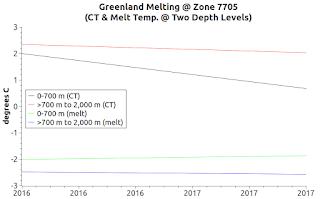 |
| Fig. 1 The Greenland |
I. Background
This post is like Antarctica 2.0 (Antarctica 2.0, 2, 3, 4, 5, 6 & supplements A, B, C, D, E, F) except that in this case we analyze the Cryosphere of Greenland (both the mythological Greenland and the real Greenland).
One of the myths about Greenland (like Antarctica) is that it only recently began to melt.
The reality is that it began to melt, primarily from atmospheric causes, a few decades after the Industrial Revolution began circa 1750 (Weekend Rebel Science Excursion - 54, The Gravity of Sea Level Change, 2, 3, 4).
The World Ocean Database (WOD) data for Greenland is sparse, so, I have updated my Greenland dataset with data from the NASA project "Oceans Melting Greenland" (OMG) because it at least has robust in situ ocean temperature and practical salinity measurements for the years 2016 and 2017 (OMG began recently).
II. Future Work
My intent for future posts, as the volume of in situ ocean water measurements increase, is to have some form of area focus for Greenland as I have for Antarctica.
Work remains to be done on links to Greenland glaciers listed on Wikipedia and on the software module that generates the graphs shown in today's post.
Past area-focus posts pertaining to Greenland have had to do with primarily atmospheric impact areas (The Question Is: How Much Acceleration Is Involved In SLR? - 10).
The oceans, for now, IMO are the main source of melting, and therefore the main focus of this series.
III. The Greenland Picture Now
Both WOD Zone data and OMG data (ocean water measurements) are not yet robust or
 |
| Fig. 1a WOD Zones of Greenland |
The map in the paper linked to and shown in Fig. 1 is composed of aerial data and other data.
That is, the data set is not based on in situ measurements of underwater conditions.
So, I am presenting graphs and links that I have now, sorted by Zone, based on in situ measurements processed into TEOS-10 values by the TEOS-10 toolkit.
Where there is a link to glaciers in a zone, I present that link.
The same goes for zones where there is WOD data available to generate a graph of values from that zone.
In Section IV below, I present a graph of all data from all individual zones (those WOD Zones are shown in Fig. 1a as superimposed on the Fig. 1 map).
I generate the best graph I can with current data:
WOD Zone [7802]
Hagen Bræ
WOD Zone [7803]
Academy
WOD Zone [7804]
Wordie
WOD Zone [7805]
Ryder
Steensby
WOD Zone [7806]
Petermann
Zone 7806
WOD Zone [7701]
Zachariae Isstrom
Zone 7701
WOD Zone [7702]
Akuliarutsip Sermerssua
Charcot
Daugård Jensen
Ejnar Mikkelsena
Ejnar Mikkelsenb
Gerard De Geer
Jætte
Kofoed Hansen Bræ
L.Bistrup Bræ
Rolige Bræ
Storstrømmen
Vestfjord
Waltershausen
Zone 7702
WOD Zone [7705]
Cornell
Hayes
Illullip Sermia
Inngia Isbræ
Kangilleq
Kjer
King Oscar
Nordenskiöld
Nunatakavsaup Sermia
Perlerfiup Sermia
Qeqertarsuup Sermia
Rink
Zone 7705
WOD Zone [7706]
Bowdoin
Harald Moltke Bræ
Humboldt
Knud Rasmussen
Peary
Zone 7706
WOD Zone [7602]
Christian IV
Kronborg
Zone 7602
WOD Zone [7603]
Christian IV
Helheim
Kangerdlugssuaq
KJV Steenstrups
Midgårds
Zone 7603
WOD Zone [7604]
Bernstorf
Avaqqat Kangerlua
Danell
Guldfaxe and Rimfaxe
Gyldenlove
Heimdal
Igutsaat
Ikertivaq
Kangerluluk
Zone 7604
WOD Zone [7605]
Jakobshavn Isbræ
Zone 7605
 |
| Fig. 2 All WOD Zones @ Greenland |
IV. Conclusion
Where there is no specific link to a specific glacier name, I link to a neighbor glacier, to a fjord where the glacier is located, or to a scientific paper that mentions that glacier.
Note that the general purpose of this post is to reveal the subsurface ocean water dynamics that are working to melt the tidewater glaciers in Greenland.
The graph at Fig. 2 is the combined trend (mean average) of all of the WOD Zone listed.
The "melt" lines on each graph show the temperature of the ice that just turned into water and mixed with the water that melted it.
The next post in this series is here.








